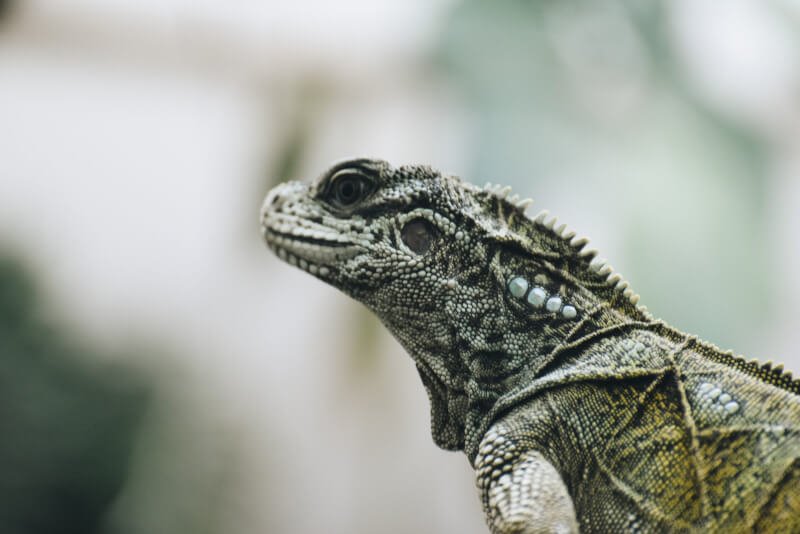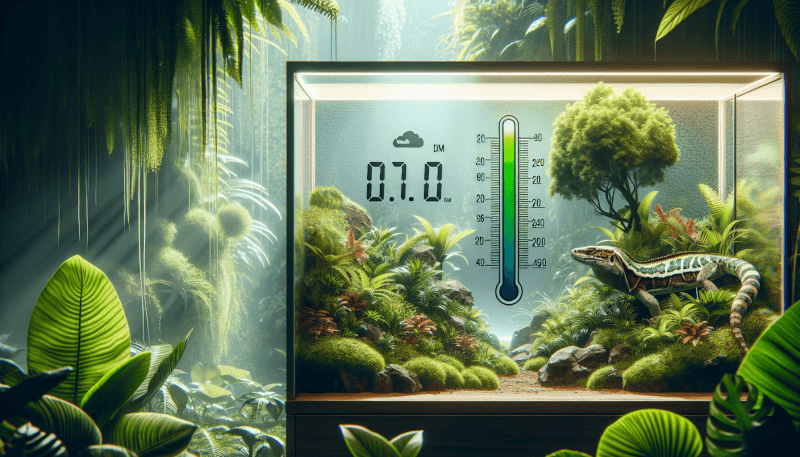Maintaining proper humidity for your reptile is crucial for its overall health and well-being. In this article, we will explore the best ways to ensure that your reptile’s environment maintains the optimal humidity levels. Whether you have a snake, turtle, or lizard, these tips and tricks will help you create a comfortable and thriving habitat for your scaly friend. From monitoring moisture levels to providing appropriate substrates, we’ve got you covered with everything you need to know to keep your reptile happy and healthy. So let’s get started and dive into the world of reptile care!

Understanding the Importance of Proper Humidity for Reptiles
Why humidity is crucial for reptiles
Humidity plays a vital role in the overall health and well-being of reptiles. Reptiles are ectothermic, meaning they rely on external sources of warmth to regulate their body temperature. Unlike mammals, reptiles cannot produce their own body heat. Instead, they depend on their environment to provide the necessary heat, and humidity is a key factor in maintaining the optimal environment for them.
The impact of low humidity on reptiles
Insufficient humidity can have detrimental effects on reptiles. Inadequate moisture in the air can lead to dehydration, respiratory issues, and difficulties with shedding. Reptiles that come from tropical regions, such as certain species of snakes and lizards, require higher levels of humidity to thrive. Low humidity levels can cause their skin to become dry and cracked, making them more susceptible to infections and other health problems.
The consequences of high humidity for reptiles
While low humidity can be detrimental, excessively high humidity also poses risks to reptiles. High humidity levels can create a breeding ground for bacteria and fungi, leading to respiratory infections and skin diseases. It can also contribute to the development of mold and mildew, which can be toxic to reptiles. Each reptile species has different humidity requirements, so striking the right balance is crucial for their overall well-being.
Determining the Ideal Humidity Level for Your Reptile
Researching the specific needs of your reptile species
To ensure that you provide the ideal humidity level for your reptile, it is essential to research the specific needs of your reptile species. Different reptile species have varying habitat requirements and may thrive in different levels of humidity. By understanding the natural environment of your reptile, you can replicate the optimal conditions in your enclosure.
Understanding the natural habitat of your reptile
Understanding the natural habitat of your reptile is crucial in determining the appropriate humidity level. For example, reptiles from tropical regions typically require higher humidity levels, while desert-dwelling reptiles need lower humidity levels. Researching and familiarizing yourself with the natural environment of your reptile will give you insights into their humidity needs.
Consulting with a veterinarian or reptile expert
If you’re unsure about the ideal humidity level for your reptile or need further guidance, consulting with a veterinarian or reptile expert is highly recommended. They can provide expert advice specific to your reptile species, taking into account factors such as age, health, and environmental conditions. A professional’s input will ensure that you provide the optimal humidity levels to keep your reptile healthy and happy.

Measuring and Monitoring Humidity Levels
Using a hygrometer to measure humidity
A hygrometer is a useful tool for measuring and monitoring humidity levels in your reptile’s enclosure. It accurately measures the amount of moisture in the air, giving you a clear understanding of the humidity levels. Hygrometers are widely available at pet stores and online, and choosing a reliable one is essential for accurate readings.
Placing hygrometers in different areas of the enclosure
To ensure accurate readings, it’s important to place hygrometers in different areas of the enclosure. Humidity levels can vary within different parts of the enclosure, especially if you have heat sources or water features. By placing hygrometers in multiple locations, you can identify any variations and make adjustments accordingly.
Regularly checking and recording humidity levels
Regularly checking and recording humidity levels is crucial for maintaining proper humidity for your reptile. By keeping a record of the humidity levels, you can identify trends, note any fluctuations, and adjust the enclosure accordingly. This will help you ensure a consistent and suitable environment for your reptile.
Creating an Enclosure with Proper Humidity
Choosing the right enclosure type
The type of enclosure you choose for your reptile can greatly impact humidity levels. Enclosures with solid sides and tops, such as glass terrariums, offer better humidity retention compared to screen enclosures. When selecting an enclosure, consider the natural habitat of your reptile and choose a design that will help maintain the required humidity levels.
The role of ventilation in maintaining humidity
While humidity is crucial, ventilation is equally important in reptile enclosures. Proper airflow helps prevent the buildup of harmful gases and ensures the exchange of fresh air. However, excessive ventilation can lead to rapid moisture loss and hinder humidity maintenance. Striking the right balance between ventilation and humidity retention is pivotal for your reptile’s well-being.
Adding a substrate that helps retain moisture
Using a substrate that aids in moisture retention is an effective way to maintain proper humidity in your reptile’s enclosure. Substrates like coconut fiber, sphagnum moss, and cypress mulch hold moisture well and release it gradually over time. Avoid substrates that quickly dry out, as they can lead to low humidity levels. Regularly misting the substrate can also help maintain the required humidity.

Providing an Adequate Water Source
Using a water bowl of appropriate size
Providing your reptile with a water bowl of an appropriate size is crucial for maintaining proper humidity levels. The size of the water bowl should allow your reptile to easily soak in it or drink from it. Additionally, a larger water bowl will increase the overall humidity in the enclosure as the water evaporates naturally.
Ensuring clean and fresh water at all times
Clean and fresh water is essential for the health of your reptile. Ensure the water bowl is cleaned regularly to prevent the growth of bacteria or algae. Refill the water bowl daily to provide your reptile with an ample supply of clean water. Having a water conditioner or purifier can further ensure the water remains safe and free from harmful contaminants.
Using water features to increase humidity
Water features, such as cascading waterfalls or misting systems, can be highly beneficial in increasing humidity levels in your reptile’s enclosure. The evaporation of water from these features will naturally raise the moisture content in the air, creating a more humid environment. However, it is important to monitor the humidity levels closely to prevent them from reaching excessively high levels.
Using Humidifiers and Foggers
Different types of humidifiers and foggers available
Humidifiers and foggers are effective tools for maintaining proper humidity levels in reptile enclosures. There are various types available, including ultrasonic humidifiers, cool-mist humidifiers, and foggers specifically designed for reptile enclosures. Each type has its own advantages and considerations, so it’s important to choose one that suits your reptile’s needs and the size of the enclosure.
Placement and proper use of humidifiers and foggers
Placing humidifiers and foggers in the right location is crucial to ensure even distribution of humidity throughout the enclosure. Position them strategically to avoid creating localized high humidity areas or moisture buildup. Following the manufacturer’s instructions for proper use, cleaning, and maintenance will help maximize their effectiveness and prevent any potential issues.
Potential drawbacks and considerations
While humidifiers and foggers can be useful tools, they also come with certain drawbacks and considerations. Excessive humidity can lead to respiratory issues and skin infections, so it’s important to monitor and regulate humidity levels closely. Additionally, certain reptiles may find the noise or vibrations from the humidifier or fogger stressful, so observe your reptile’s behavior and make adjustments accordingly.

Misting the Enclosure
Benefits of hand misting
Hand misting is a simple and effective method to increase humidity in your reptile’s enclosure. By manually spraying water into the air, you can create a fine mist that settles on surfaces and helps elevate humidity levels. Hand misting allows for targeted hydration and is beneficial for reptiles that enjoy drinking water droplets or moistening their skin.
Determining the frequency of misting
The frequency of misting will depend on the specific needs of your reptile and the desired humidity level. Some reptiles may require misting multiple times a day, while others may only need it once a day or every few days. Observe your reptile’s behavior and regularly measure the humidity to determine the appropriate misting schedule.
Avoiding excessive moisture or wet surfaces
While misting is an effective method for increasing humidity, it’s crucial to avoid excessive moisture or wet surfaces. Excess moisture can lead to bacterial and fungal growth, as well as create an uncomfortable environment for your reptile. Ensure proper ventilation and allow surfaces to dry adequately between misting sessions to maintain a healthy and comfortable enclosure.
Utilizing Live Plants in the Enclosure
Suitable reptile-safe plants that increase humidity
Introducing live plants to your reptile’s enclosure not only enhances the aesthetic appeal but also increases humidity levels. Certain reptile-safe plants, such as pothos, bromeliads, and ferns, thrive in the warm and humid environment of reptile enclosures. These plants release moisture through transpiration, naturally increasing the humidity levels and creating a more natural and enriching habitat for your reptile.
Maintaining and caring for live plants
To ensure the well-being of the live plants, proper care and maintenance are essential. Provide adequate lighting and ensure that any fertilizers or pesticides used are safe for reptiles. Regularly water the plants and monitor their growth to prevent overcrowding and the accumulation of decaying plant matter. It’s also important to regularly inspect the plants for any signs of pests or diseases.
Monitoring for any harmful effects on reptile health
While live plants can offer many benefits, it’s important to monitor your reptile for any potential harmful effects. Some reptiles may eat or destroy the plants, which could lead to digestive issues or blockages. Additionally, certain plants may release toxins or cause skin irritation in reptiles. If you notice any adverse effects on your reptile’s health, it may be necessary to remove or replace the live plants.

Creating a Humid Hide or Moisture Chamber
Understanding the purpose of a humid hide
A humid hide, also known as a moisture chamber, provides your reptile with a specific area of increased humidity within their enclosure. This hide mimics the natural microenvironment that some reptiles seek out to aid in shedding or to regulate their hydration levels. Humid hides are especially beneficial for reptiles that come from tropical or humid regions and require higher levels of humidity.
Choosing the right materials for a humid hide
When creating a humid hide, it’s important to choose appropriate materials that retain moisture well. Sphagnum moss, coco coir, and vermiculite are commonly used as substrates for humid hides. These materials hold moisture effectively and provide a humid microenvironment for your reptile to utilize when needed.
Placing the humid hide in the enclosure
The placement of the humid hide is crucial to ensure it serves its purpose effectively. Position the humid hide in a low-traffic area of your reptile’s enclosure, providing easy access for your reptile while also offering them a private and secluded space. You can use caves, plastic containers, or commercially available humid hide boxes to create the perfect hideout for your reptile.
Adjusting Humidity for Shedding
Identifying signs of shedding
Shedding is a natural process for reptiles to rejuvenate their skin. It’s important to be attentive to signs that indicate your reptile is preparing for shedding. These signs may include changes in behavior, loss of appetite, and the appearance of dull or discolored skin. By recognizing these signs, you can take appropriate measures to adjust the humidity levels in preparation for shedding.
Increasing humidity during shedding process
During the shedding process, it’s important to increase the humidity levels to facilitate the shedding of old skin. Most reptiles require higher humidity levels during shedding, and providing this for them can help them shed more easily and reduce the risk of complications. Utilize methods such as misting, humid hides, or increasing the frequency of water bowl refills to create the necessary humidity.
Providing proper hydration and moisture
In addition to increasing humidity, it’s crucial to provide your reptile with adequate hydration and moisture during the shedding process. Adding a water dish with slightly warmer water than usual can help loosen the shedding skin and ease the process for your reptile. Regularly misting the enclosure and ensuring access to fresh water are also important to maintain hydration levels during shedding.
In conclusion, maintaining proper humidity is indispensable for the health and well-being of reptiles. By understanding the importance of humidity, researching your reptile’s specific needs, and employing various methods to adjust humidity levels, you can create an optimal environment for your reptile to thrive. Remember to engage in regular monitoring and consult with professionals when necessary to ensure the ideal humidity for your reptile’s unique requirements.


